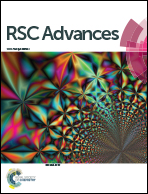Hydrazone connected stable luminescent covalent–organic polymer for ultrafast detection of nitro-explosives†
Abstract
Developing promising luminescent probes for the selective sensing of nitro-explosives remains a challenging issue. Porous luminescent covalent–organic polymers are one of the excellent sensing probes for trace hazardous materials. Herein, fluorescent monomers 1,1,2,2-tetrakis(4-formyl-(1,1′-biphenyl))ethane (TFBE) and 1,3,5-benzenetricarboxylic acid trihydrazide (BTCH) were selected to build a novel hydrazone connected stable luminescent covalent–organic polymer (H-COP) of high stability by typical Schiff-base reaction. The N2 sorption study, BET surface area analysis, and TGA profile indicate the porosity and stability of this H-COP material. Such properties of the H-COP material enable a unique sensing platform for nitro-explosives with great sensitivity (Ksv ∼ 106 M) and selectivity up to μM. This polymer material shows attractive selectivity and sensitivity towards phenolic nitro-explosives and other common explosives among earlier reported COP-based sensors.



 Please wait while we load your content...
Please wait while we load your content...